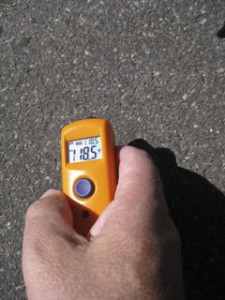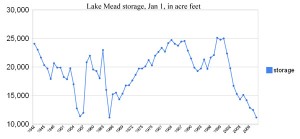It has long been apparent that the water supply of the Colorado is inadequate for all the demands that will be made upon it, as is the case with many other streams in the West.
That is G.E.P. Smith of the University of Arizona, writing in the Proceedings of the American Society of Civil Engineers in November 1924.

Colorado River hydrologist E.C. LaRue, courtesy USGS
I’ve long been of the belief that it was the unusual wet period of the first two decades of the 20th century that led early westerners to believe there was plenty of water in the Colorado, and that misunderstanding was at the core of the set of problems we now face. But an intriguing volume I’ve been reading suggests a more complex picture – that even then there were substantial voices arguing there was not enough water in the Colorado. The book is a doctoral thesis written in 1926 by Reuel Leslie Olson on The Colorado River Compact (which I picked up over the summer at Sam Weller’s, an epic western bookstore in Salt Lake City which I had the strange fortune to visit just days after Weller’s death). Olson’s account has the charming virtue of immediacy, written in the years after the Compact was signed, but before the concrete to implement it had been poured.
My belief regarding the unusual wet period is not wrong. It is clear that the compact’s framers only had twenty years of river records to go on when they divided up the Colorado’s waters, but that they assumed that was sufficient to capture the full range of natural variability. Here, for example, is Delph Carpenter, the state of Colorado’s representative and the real genius behind the Compact:
The hydrographers and experts advise me that a twenty-year record on a river is adequate in its completeness and includes enough years to warrant an assumption that the average there deduced would be the average flow of the river in the future.
And we know from the tree ring record that those 20 years were “one of the wettest periods in the past 5 centuries” (Woodhouse, C.A., S.T. Gray, and D.M. Meko, 2006. Updated streamflow reconstructions for the Upper Colorado River basin. Water Resources Research, 42, W05415. doi:10.1029/2005WR004455).
That right there was a recipe for disaster, a misunderstanding of the amount we had in the bank as we were writing the West’s great check.
But Olson’s on-the-spot 1926 analysis makes clear that, even then, there was widespread fear that even given what we now know was a rosy streamflow scenario, there were people who thought there was simply not enough water in the Colorado to do what they were contemplating.
Most powerful among those voices was E.C. LaRue, the hydrologist who laid the groundwork for the subsequent development of the Colorado. Testifying before the U.S. House of Representatives in March, 1924, LaRue said this:
On page 167 of my report, Colorado River and its Utilization, published in 1916 by the United States Geological Survey … will be found the following conclusions: “Evidently the flow of Colorado River and its tributaries is not sufficient to irrigate all the irrigable lands lying within the basin….”
That is the conclusion I reached in 1916.
Additional data collected by myself and others in recent years prove that this conclusion is correct….
It is something that should have been broadcast six or eight years ago … instead of saying that there is plenty of water for all.
, in addition to sharing the stories of scientists I tried to give young readers examples of science they can do themselves. As a science journalist, I got hooked on weather years ago because the sciency bits connect so nicely to readers’ everyday experience. It’s just one short step, I hope, to teaching young people how they can use the weather as an introduction to the act of measuring and recording their world.
.





